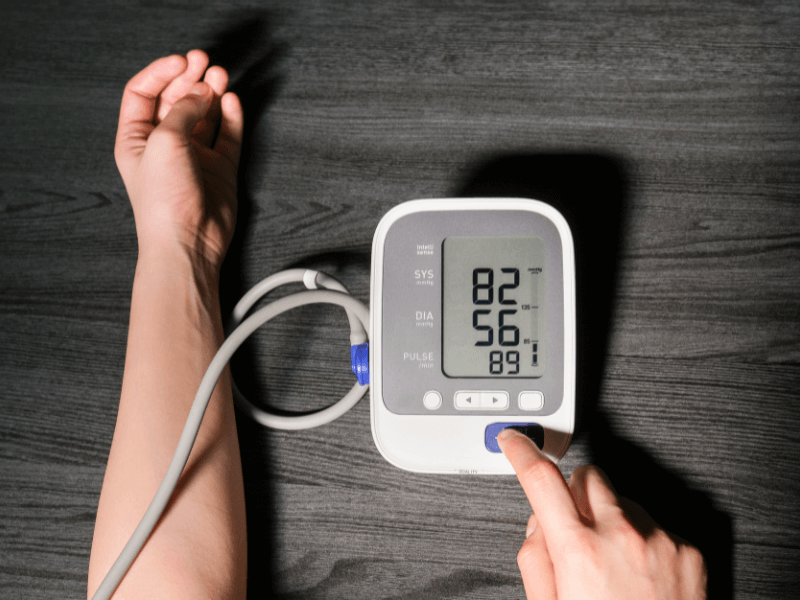Understanding Low Blood Pressure, medically known as hypotension, occurs when your blood pressure reading drops below 90/60 mmHg. While many associate high blood pressure with health risks, low blood pressure can also cause discomfort and even serious complications if not properly managed.
This article explains the causes, symptoms, and treatment options for low blood pressure—along with specific nutrition tips to support healthy blood pressure levels.
What Is Low Blood Pressure?
Blood pressure is the force of your blood pushing against the walls of your arteries. A normal reading is around 120/80 mmHg. When it falls too low, your organs may not receive enough blood and oxygen, leading to symptoms such as dizziness and fatigue.
Common Causes of Low Blood Pressure

Low blood pressure can be triggered by various factors:
- Dehydration – Losing too much fluid through vomiting, diarrhoea, or not drinking enough water can reduce blood volume.
- Nutritional deficiencies – Low levels of vitamin B12, folate, and iron can affect red blood cell production, leading to anaemia and low pressure.
- Hormonal imbalances – Conditions like Addison’s disease or thyroid disorders can disrupt blood pressure regulation.
- Prolonged bed rest or inactivity – Reduces circulatory efficiency.
- Pregnancy – Blood vessels expand, often causing pressure to drop in the first 24 weeks.
- Heart problems – Slow heart rate, valve issues, or heart failure can contribute.
- Medications – Diuretics, antidepressants, and beta-blockers can lower blood pressure.
- Sudden position changes – Postural or orthostatic hypotension occurs when standing up too quickly.
Signs and Symptoms of Low Blood Pressure

Symptoms vary but commonly include:
- Dizziness or light-headedness
- Blurred vision
- Fainting
- Fatigue or weakness
- Cold, clammy skin
- Nausea
- Difficulty concentrating
- Rapid or shallow breathing
If you frequently experience these symptoms, it’s important to speak to a healthcare provider.
Nutritional Management for Low Blood Pressure

Proper diet plays a key role in managing and preventing hypotension. Here’s how nutrition can help:
1. Increase Fluid Intake
Dehydration is a leading cause of low blood pressure. Drink at least 8–10 glasses of water daily. Include electrolyte-rich fluids like coconut water, lemon water with salt, or oral rehydration solutions, especially in hot climates.
2. Eat Small, Frequent Meals
Large meals can cause postprandial hypotension—a drop in blood pressure after eating. Opt for 4–6 smaller meals spread throughout the day.
3. Add a Little Extra Salt (if advised)
Unlike high BP, in some hypotension cases, a slight increase in sodium intake may help raise blood pressure. Always consult a doctor or dietitian before modifying salt intake.
4. Focus on Iron and B12
To prevent anaemia-related low blood pressure, eat foods rich in:
- Iron: spinach, lentils, lean meat, pumpkin seeds
- Vitamin B12: eggs, dairy, fortified cereals, fish
- Folate: citrus fruits, leafy greens, legumes
5. Include Complex Carbohydrates
Whole grains, oats, and brown rice provide steady energy and reduce chances of post-meal blood pressure drops.
6. Avoid Alcohol
Alcohol can dehydrate the body and worsen hypotension.
7. Add Natural Blood Pressure Supporters
- Beetroot juice: Known to stabilize BP
- Licorice tea: May help raise blood pressure but should be taken cautiously and short-term
- Caffeine (in moderation): Coffee or tea can provide temporary BP elevation
Lifestyle Tips to Manage Low Blood Pressure

- Get up slowly from bed or a sitting position
- Wear compression stockings to improve circulation
- Avoid standing for long periods
- Exercise regularly, focusing on low-intensity activities like walking or swimming
- Track blood pressure daily if you are prone to hypotension
When to See a Doctor
While mild hypotension isn’t always a concern, seek medical attention if you experience:
- Repeated fainting spells
- Severe fatigue
- Chest pain or difficulty breathing
- Persistent dizziness or confusion
These may indicate a more serious underlying issue such as internal bleeding, shock, or cardiac problem.
Low blood pressure may seem harmless, but persistent symptoms should not be ignored. Managing hydration, maintaining balanced nutrition, and making small lifestyle adjustments can help keep your blood pressure within a healthy range.
If you’re struggling with frequent hypotension or symptoms like fatigue and dizziness, speak with a healthcare professional and consider working with a registered dietitian to create a meal plan that supports better circulation and energy levels.
low blood pressure causes, low blood pressure symptoms, hypotension diet, how to treat low blood pressure naturally, low bp home remedies, low blood pressure foods, hypotension nutrition tips, how to increase blood pressure with diet.



